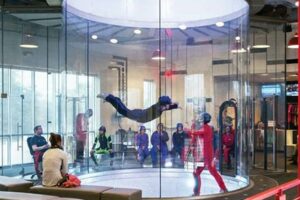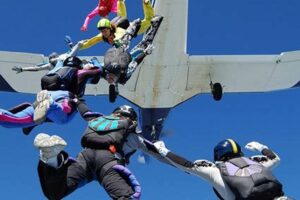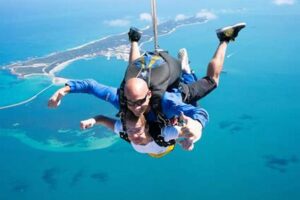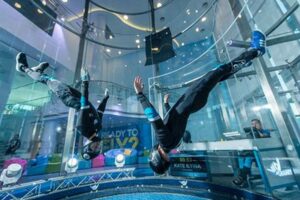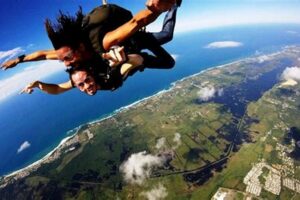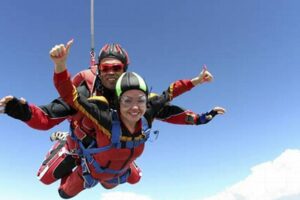Table of Contents
Skydiving Apparel: The Ultimate Guide to Gear for a Thrilling Experience
Clothing for skydiving, encompassing specialized suits, helmets, and goggles, is paramount for ensuring a safe and exhilarating freefall adventure. These protective garments, meticulously designed to withstand extreme conditions, safeguard skydivers from the harsh elements and potential hazards encountered during their descent.
The significance of appropriate skydiving attire extends beyond safety. It plays a crucial role in enhancing the overall skydiving experience. Well-fitted suits minimize wind resistance, allowing for better control and stability during the jump. Specialized helmets protect the head from impact and provide a secure platform for communication devices. Goggles shield the eyes from strong winds and airborne particles, ensuring clear vision throughout the descent.
The evolution of skydiving clothing has been driven by advancements in materials and technology. The introduction of lightweight, breathable fabrics and the incorporation of aerodynamic designs have significantly improved comfort and maneuverability. Additionally, the integration of safety features, such as reinforced seams and impact-resistant materials, has further enhanced the protective capabilities of skydiving attire.
As we delve into the intricacies of skydiving clothing, we will explore the various types of suits, helmets, and goggles available, highlighting their unique features and suitability for different skydiving disciplines. Furthermore, we will provide valuable tips on choosing the right gear, ensuring proper fit and maintenance, and maximizing safety and enjoyment during your skydiving adventure.
Clothing for Skydiving
When it comes to skydiving, the right clothing is essential for ensuring a safe and enjoyable experience. Key aspects to consider include:
- Safety: Protective gear minimizes risks.
- Comfort: Well-fitted suits enhance maneuverability.
- Aerodynamics: Streamlined designs reduce wind resistance.
- Visibility: Clear goggles ensure unobstructed vision.
- Communication: Helmets facilitate clear communication.
- Temperature Control: Layering allows for changing conditions.
- Durability: Strong materials withstand extreme conditions.
- Fit: Proper sizing maximizes comfort and safety.
- Maintenance: Regular care extends gear lifespan.
- Style: Express individuality with colorful designs.
These aspects are interconnected and contribute to the overall skydiving experience. For instance, safety is paramount, and protective clothing minimizes the risk of injury. Comfort is also crucial, as a well-fitted suit allows for greater freedom of movement and control during the jump. Additionally, aerodynamic designs reduce wind resistance, enhancing stability and control during freefall. Ultimately, the right clothing choices can make the skydiving experience safer, more enjoyable, and more stylish.
Safety
In the realm of skydiving, where safety is of utmost importance, protective clothing plays a pivotal role in minimizing risks and ensuring a successful jump. This specialized gear is meticulously designed to safeguard skydivers from potential hazards encountered during their descent, providing peace of mind and confidence.
- Structural Integrity: Protective suits are constructed from durable materials that can withstand the extreme forces encountered during freefall. Reinforced seams and abrasion-resistant fabrics ensure the suit’s integrity, preventing tears and rips that could compromise safety.
- Impact Protection: Helmets are essential for shielding the head from potential impacts. Made from lightweight yet sturdy materials, these helmets absorb and disperse impact energy, minimizing the risk of serious head injuries.
- Goggle Protection: Goggles serve as a crucial protective barrier for the eyes. They shield the eyes from strong winds, dust, and airborne particles, preventing irritation and ensuring clear vision throughout the jump.
- Communication and Navigation: Protective helmets often incorporate communication systems, allowing skydivers to stay connected with their instructors or fellow jumpers. Additionally, helmets may be equipped with navigation devices, providing real-time information on altitude, speed, and direction.
These protective measures work in unison to minimize risks and enhance the overall safety of skydiving. Structural integrity safeguards the body from impact forces, helmets protect the head from potential injuries, goggles shield the eyes from harsh elements, and communication systems facilitate effective communication and navigation. By investing in high-quality protective clothing, skydivers can mitigate risks and focus on enjoying the exhilarating experience of freefall.
Comfort
In the realm of skydiving, where precision and control are paramount, comfort plays a vital role in ensuring a successful and enjoyable jump. Well-fitted suits, meticulously tailored to the individual skydiver’s body, enhance maneuverability and allow for greater freedom of movement during freefall.
- Mobility and Flexibility: Snug-fitting suits provide a second-skin-like feel, allowing skydivers to move and twist effortlessly. This enhances their ability to control their body position and execute maneuvers with precision.
- Aerodynamic Profile: A well-fitted suit minimizes excess fabric and creates a sleek aerodynamic profile, reducing wind resistance and drag. This results in improved stability and control during freefall, allowing skydivers to maintain their desired position and trajectory.
- Reduced Fatigue: Ill-fitting suits can cause chafing, discomfort, and fatigue, hindering the skydiver’s ability to focus and perform at their best. A well-fitted suit eliminates these distractions, allowing skydivers to remain comfortable and focused throughout the jump.
- Confidence and Enjoyment: When skydivers feel comfortable and confident in their clothing, they are more likely to push their limits and explore new maneuvers. A well-fitted suit instills confidence and encourages skydivers to embrace the exhilarating experience of freefall.
In conclusion, the comfort provided by well-fitted suits is an integral aspect of skydiving. By enhancing maneuverability, reducing fatigue, and promoting confidence, these suits empower skydivers to perform at their best and fully enjoy the freedom and exhilaration of freefall.
Aerodynamics
In the realm of skydiving, where speed and control are paramount, aerodynamics plays a crucial role in ensuring a safe and exhilarating experience. Streamlined designs of clothing and equipment minimize wind resistance, enhancing stability, maneuverability, and overall performance during freefall.
- Body Suit Design: Skydiving suits are meticulously designed to fit snugly and reduce excess fabric. This streamlined profile minimizes drag, allowing skydivers to maintain their desired position and trajectory with greater ease.
- Helmet Shape: Aerodynamic helmets are shaped to minimize wind resistance and
turbulence. This reduces buffeting and improves stability, particularly at high speeds. - Contoured Limbs: Wingsuits and specialized jumpsuits often incorporate contoured limbs to create a smooth, streamlined surface. This design reduces drag and enhances the skydiver’s ability to control their body position during freefall.
- Material and Texture: The choice of materials and textures also contributes to aerodynamic efficiency. Smooth, low-friction fabrics and strategically placed textured panels help manage airflow and minimize resistance.
By optimizing aerodynamics through streamlined designs, skydivers can achieve greater stability, enhanced maneuverability, and improved overall performance during their jumps. These aerodynamic considerations are integral to the design and development of clothing and equipment for skydiving, ensuring a safe and exhilarating experience for jumpers of all skill levels.
Visibility
In the realm of skydiving, where split-second decisions and precise maneuvers are crucial, clear vision is paramount. Specialized goggles play a vital role in ensuring unobstructed vision, enabling skydivers to navigate the skies safely and confidently.
- Panoramic View: Skydiving goggles are designed with wide lenses that provide a panoramic field of view, allowing skydivers to maintain situational awareness and monitor their surroundings during the jump.
- Anti-Fogging Technology: To prevent fogging and ensure clear vision, skydiving goggles incorporate anti-fogging coatings or ventilation systems that minimize condensation and maintain clarity even in humid or cold conditions.
- Scratch Resistance: The lenses of skydiving goggles are often treated with scratch-resistant coatings to protect them from abrasions and maintain optical clarity. This is especially important considering the high speeds and potential for airborne particles during a skydive.
- Tinted Lenses: Some skydiving goggles feature tinted lenses to reduce glare and enhance visibility in bright sunlight. These lenses can also help to improve contrast and definition, making it easier to distinguish objects and landmarks during the jump.
By ensuring clear and unobstructed vision, skydiving goggles contribute to the overall safety and enjoyment of the skydiving experience. They allow skydivers to make informed decisions, navigate accurately, and fully appreciate the breathtaking views during their descent.
Communication
In the realm of skydiving, where precise coordination and situational awareness are crucial, communication plays a vital role. Specialized helmets are equipped with integrated communication systems that enable skydivers to stay connected and exchange critical information during their jumps.
- Integrated Intercoms: Helmets often incorporate built-in intercom systems that allow skydivers to communicate with each other and with ground control. These systems facilitate real-time coordination, enabling jumpers to relay information about their positions, altitudes, and intentions.
- Noise Cancellation: Skydiving helmets are designed to minimize background noise, such as wind and engine noise, to ensure clear and effective communication. This allows skydivers to focus on incoming messages and respond promptly.
- Hands-Free Operation: Helmet-mounted communication systems are typically voice-activated or operated via push-to-talk buttons, allowing skydivers to communicate without taking their hands off their controls. This enhances safety and allows for seamless coordination during complex maneuvers.
- Compatibility with External Devices: Some helmets feature Bluetooth or other wireless connectivity options, enabling skydivers to connect to external devices such as GPS trackers or music players. This allows them to access additional information or entertainment during their jumps.
By facilitating clear and reliable communication, helmets play a crucial role in ensuring the safety and coordination of skydivers during their jumps. The integration of advanced communication systems into skydiving helmets empowers jumpers to stay connected, share information, and make informed decisions throughout their descent.
Temperature Control
In the realm of skydiving, where rapid changes in altitude and airspeed can lead to fluctuating temperatures, maintaining optimal body temperature is essential for both comfort and safety. Layering clothing provides skydivers with the flexibility to adapt to varying conditions throughout their jump, ensuring a more enjoyable and controlled experience.
- Base Layer:
The foundation of a layering system, base layers are typically made from moisture-wicking materials that draw sweat away from the skin, keeping the skydiver dry and comfortable.
- Mid Layer:
Mid layers provide insulation and warmth. Fleece, wool, and synthetic materials are commonly used for their ability to trap heat, while still allowing breathability.
- Outer Layer:
The outer layer serves as a protective barrier against wind, rain, and cold. Waterproof and windproof materials are essential for maintaining body heat and preventing hypothermia.
- Accessories:
Accessories such as gloves, hats, and scarves can provide additional warmth and protection for exposed areas of the body.
By layering clothing appropriately, skydivers can maintain a comfortable body temperature, reducing the risk of hypothermia or overheating. This allows them to focus on the task at hand, enjoy the experience, and make quick decisions in response to changing conditions.
Durability
In the realm of skydiving, durability takes center stage as clothing must endure extreme conditions throughout the jump. Strong and resilient materials are essential to ensure the safety, comfort, and performance of skydivers.
- Ripstop Fabrics:
Ripstop fabrics are woven with reinforced threads that prevent tears from spreading, ensuring the integrity of the suit even under high stress.
- Abrasion-Resistant Materials:
Materials like Cordura and Kevlar are highly resistant to abrasion, protecting the suit from wear and tear caused by friction with the air and equipment.
- Reinforced Seams:
Critical seams are reinforced with additional stitching or tape to enhance durability and prevent seam failure during high-speed maneuvers.
- Durable Zippers:
Zippers are subjected to repeated use and strain. Strong, corrosion-resistant zippers ensure smooth operation and prevent breakage during critical moments.
The exceptional durability of clothing for skydiving safeguards skydivers from potential hazards and injuries. Strong materials provide peace of mind, allowing them to focus on controlling their descent and enjoying the exhilarating experience of freefall.
Fit
In the realm of skydiving, where precision and control are paramount, proper fit plays a crucial role in ensuring both comfort and safety. Ill-fitting clothing can hinder mobility, impair decision-making, and potentially lead to dangerous situations during freefall.
- Mobility and Maneuverability:
Well-fitted clothing allows for unrestricted movement and effortless control of the body during freefall. It enables skydivers to execute maneuvers with precision and respond swiftly to changing conditions.
- Aerodynamic Profile:
Properly fitted clothing minimizes excess fabric and creates a streamlined profile, reducing wind resistance and drag. This enhances stability, control, and overall performance during the jump.
- Safety and Protection:
Clothing that fits snugly provides better protection against potential hazards. It minimizes the risk of entanglement with equipment or the parachute and ensures that safety devices, such as reserve parachutes, deploy properly.
- Comfort and Confidence:
Well-fitted clothing enhances comfort levels, reducing distractions and allowing skydivers to focus on the task at hand. It instills confidence and enables skydivers to perform at their best.
In summary, proper fit is an integral aspect of clothing for skydiving. By ensuring optimal mobility, enhancing safety, and promoting comfort, well-fitted clothing empowers skydivers to perform at their best and fully embrace the exhilarating experience of freefall.
Maintenance
In the realm of skydiving, where safety and performance are paramount, regular maintenance of clothing and equipment is a critical component of ensuring gear longevity and the overall skydiving experience.
Cause and Effect: Regular maintenance, including proper cleaning, inspection, and repairs, directly extends the lifespan of clothing for skydiving. By removing dirt, debris, and potential contaminants, regular cleaning prevents wear and tear, menjaga gear in optimal condition. Inspections allow for early detection and repair of any damage or defects, minimizing the risk of catastrophic failures during a jump. Regular maintenance also ensures that all components, such as zippers, buckles, and straps, function properly, enhancing safety and reliability.
Real-Life Examples: Skydivers who meticulously maintain their clothing and equipment often enjoy longer gear lifespans. Regular cleaning prevents the accumulation of dirt and sweat, which can degrade materials and lead to premature wear. Timely repairs address minor issues before they escalate into major problems, reducing the likelihood of costly replacements. Additionally, proper maintenance ensures that all safety features, such as reserve parachutes and automatic activation devices, are in perfect working order, giving skydivers peace of mind.
Practical Applications: Understanding the relationship between regular maintenance and gear longevity empowers skydivers to take proactive steps in prolonging the lifespan of their clothing and equipment. By dedicating time for routine cleaning and inspections, skydivers can identify and address potential issues early on, preventing costly repairs or replacements. Regular maintenance also contributes to the overall safety and reliability of the gear, giving skydivers the confidence to focus on enjoying the skydiving experience.
In summary, regular maintenance is a critical aspect of clothing for skydiving, directly influencing gear lifespan, safety, and overall performance. By embracing a proactive approach to maintenance, skydivers can extend the lifespan of their gear, minimize the risk of failures, and enhance their skydiving experience.
Style
In the realm of skydiving, where safety and functionality are paramount, personal style also plays a significant role. Skydivers often seek clothing and accessories that reflect their individuality and allow them to stand out in the skies. This desire for self-expression through colorful designs has become an integral aspect of clothing for skydiving.
- Patterns and Colors: Skydivers can choose from a wide range of patterns and colors to create unique and eye-catching jumpsuits. These designs not only enhance visibility in the air but also allow skydivers to express their personalities and preferences.
- Graphics and Logos: Many skydivers opt for clothing adorned with graphics, logos, or personal messages. These designs can represent their skydiving club, sponsors, or simply reflect their personal interests and passions.
- Embroidery and Appliqus: Some skydivers take their style to the next level by incorporating embroidery or appliqu work onto their jumpsuits. These intricate designs add a touch of elegance and sophistication to their skydiving attire.
- Accessories: Accessories such as helmets, goggles, and gloves also provide opportunities for skydivers to express their personal style. These items can be color-coordinated with the jumpsuit or feature unique designs that reflect the skydiver’s personality.
The freedom to express individuality through colorful designs extends beyond aesthetics. It fosters a sense of community and camaraderie among skydivers, who often recognize and appreciate each other’s unique style choices. Additionally, it allows skydivers to showcase their creativity and passion for the sport, contributing to the overall vibrant and dynamic culture of skydiving.
In conclusion, style plays a significant role in clothing for skydiving, allowing jumpers to express their individuality and creativity while enhancing visibility and fostering a sense of community. The wide range of patterns, colors, graphics, and accessories available empowers skydivers to create unique and eye-catching jumpsuits that reflect their personal preferences and passions.
Frequently Asked Questions (FAQs) on Clothing for Skydiving
This section aims to address common queries and provide clarity on various aspects of clothing for skydiving. These FAQs cover essential topics, from safety and comfort to maintenance and style.
Question 1: What are the primary considerations when choosing skydiving clothing?
Answer: Prioritize safety, comfort, aerodynamics, visibility, communication, temperature control, durability, fit, maintenance, and personal style when selecting skydiving attire. These factors collectively contribute to a safe, enjoyable, and stylish skydiving experience.
Question 2: How does clothing impact safety during skydiving?
Answer: Protective suits, helmets, and goggles safeguard skydivers from potential hazards encountered during freefall. Well-fitted clothing minimizes wind resistance, enhancing stability and control. Additionally, durable materials withstand extreme conditions, providing peace of mind.
Question 3: What clothing layers are recommended for skydiving?
Answer: Layering clothing allows skydivers to adapt to changing temperatures. Base layers wick away sweat, mid layers provide insulation, and outer layers protect against wind and rain. Accessories like gloves and hats offer additional warmth.
Question 4: How can I ensure my skydiving clothing fits properly?
Answer: Proper fit is crucial for comfort, safety, and performance. Clothing should fit snugly without restricting movement. Well-fitted suits minimize excess fabric, reducing drag and enhancing aerodynamics.
Question 5: How should I maintain my skydiving clothing and gear?
Answer: Regular maintenance extends the lifespan of skydiving clothing and equipment. Cleaning removes dirt and debris, preventing wear and tear. Inspections identify potential issues early, allowing for timely repairs. Proper maintenance ensures optimal performance and safety.
Question 6: Can I express my personal style through skydiving clothing?
Answer: Skydivers can personalize their attire with colorful designs, graphics, logos, and accessories. This self-expression enhances visibility, fosters a sense of community, and allows skydivers to showcase their creativity and passion for the sport.
These FAQs provide valuable insights into the selection, use, and maintenance of clothing for skydiving. As we delve deeper into this topic, the next section will explore advanced considerations and techniques for optimizing comfort, safety, and performance during skydiving jumps.
Tips for Enhancing
Your Skydiving Experience
This section provides valuable tips to optimize your skydiving experience, ensuring both safety and enjoyment. By following these recommendations, skydivers can enhance their performance, comfort, and overall satisfaction during their jumps.
Tip 1: Choose Clothing and Equipment Meticulously: Select skydiving clothing and equipment that prioritize safety, comfort, and functionality. Ensure proper fit and familiarize yourself with the gear’s features and operation.
Tip 2: Master Proper Body Position: Maintain a stable and streamlined body position during freefall. This minimizes drag, enhances control, and improves overall stability. Practice proper body position during ground training and wind tunnel sessions.
Tip 3: Focus on Controlled Movement: Avoid abrupt or excessive movements during freefall. Controlled and smooth movements ensure better stability and control. This is especially important when executing maneuvers or deploying the parachute.
Tip 4: Be Aware of Your Surroundings: Develop situational awareness during freefall. Continuously scan your surroundings to monitor other skydivers, aircraft, and potential hazards. This enhances safety and allows for timely decision-making.
Tip 5: Practice Emergency Procedures: Thoroughly understand and practice emergency procedures before your jump. This includes deploying the reserve parachute, performing malfunctions drills, and communicating effectively with ground control. Preparedness is key to managing unexpected situations.
Tip 6: Stay Calm and Composed: Skydiving can be exhilarating, but it’s essential to remain calm and composed throughout the jump. This allows for clear thinking, quick decision-making, and better control of your body and emotions.
Tip 7: Communicate Effectively: Maintain effective communication with your fellow skydivers, instructors, and ground control. Use proper radio etiquette and hand signals to ensure clear and timely communication. This is crucial for coordinating maneuvers, managing emergencies, and ensuring overall safety.
Tip 8: Continuously Learn and Improve: Skydiving is a skill that requires continuous learning and improvement. Seek opportunities for additional training, practice, and feedback. The more knowledgeable and experienced you are, the safer and more enjoyable your skydiving experience will be.
By following these tips, skydivers can enhance their safety, improve their performance, and maximize their enjoyment of the sport. These recommendations lay the foundation for a successful and fulfilling skydiving experience, preparing jumpers for the challenges and rewards that await them in the skies.
As we conclude this exploration of clothing and tips for skydiving, the next section delves into the overarching theme of safety in the sport. We will examine the critical role of training, regulations, and equipment inspections in ensuring a safe and enjoyable skydiving environment for all.
Conclusion
Our exploration of clothing for skydiving has unveiled the intricate interplay between safety, comfort, and style in this exhilarating sport. Key considerations include selecting protective gear that minimizes risks, choosing well-fitted suits for optimal mobility and aerodynamics, and ensuring clear visibility and effective communication. Layering clothing allows for adaptation to changing temperatures, while regular maintenance extends gear longevity and enhances safety.
The interconnectedness of these factors is evident. Proper fit not only enhances comfort but also minimizes wind resistance and improves stability during freefall. Clear visibility through goggles is crucial for situational awareness and safe navigation, while effective communication enables coordination and timely response to changing conditions.
As we conclude, remember that skydiving is an activity where safety should never be compromised. Invest in high-quality protective clothing, undergo proper training, and adhere to safety regulations. By prioritizing safety and making informed choices about clothing and equipment, skydivers can unlock the full potential of this exhilarating sport and create lasting memories in the skies.

